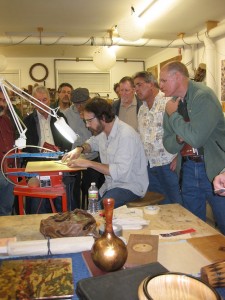We may receive a commission when you use our affiliate links. However, this does not impact our recommendations.
David J. Marks is recognized internationally as a master furniture maker, turner and sculptor. He hosted 91 episodes of the television show “WoodWorks,” which debuted on HGTV and the DIY Networks back in 2001.
Today, David works and teaches at his studio in Santa Rosa, California. I caught up with him last week to discuss his varied and impressive career.
Dan: What are the most notable changes in the studio furniture world during the course of your career?
David: A lot of it has to do with influences. When I was starting out, there were some incredible, influential woodworkers here in California – Sam Maloof, James Krenov, Gary Knox Bennett and Art Carpenter (to name a few). As I got exposed to these guys, I learned that they referred to themselves as designer-craftsmen, and I learned what that meant. It meant they did it all, from designing and building all the way through marketing their pieces. Nowadays, you hear guys saying it’s OK to use CNC in certain parts of their work. You even hear guys saying it’s OK to outsource work. That’s all different from how the studio world used to be.
Dan: Are there still enough designer-craftsman influences?
David: Yes, there are plenty of old-school woodworkers to keep good production going. The question becomes, can you sustain yourself financially? Teaching is a way to still be involved in the process [while supplementing other woodworking income]. A lot of the big names of old also taught.
Dan: Speaking of teaching other woodworkers, it seems to me you are very good at crossing barriers and really connecting with students. You also avoid setting up major barriers between so-called “beginner” and “advanced” students. Tell us more about your teaching approach.
 David: The most important thing is the attitude. When I first got started in 1972, none of the big woodworking magazines really existed, and it was hard to find good resources for skill development. My beginnings were extremely humble. I realized my skills needed to improve, so I worked for a variety of shops. My attitude was to always be a student. Ever since then, I have always stayed in the trenches. The first thing I say to students in my classes today is, “We’re all climbing the ladder together.”
David: The most important thing is the attitude. When I first got started in 1972, none of the big woodworking magazines really existed, and it was hard to find good resources for skill development. My beginnings were extremely humble. I realized my skills needed to improve, so I worked for a variety of shops. My attitude was to always be a student. Ever since then, I have always stayed in the trenches. The first thing I say to students in my classes today is, “We’re all climbing the ladder together.”
Dan: I want to switch gears briefly to your commission work and award-winning artistry in wood. When did you feel you had fully developed your own artistic vision and what is it today?
David: [Laughs.] Well, the first time I considered myself to be an artist was in third grade. Now I chuckle at that. I went to an art school and produced a pastel painting. My parents put it on the refrigerator, and that did it!
I studied drawing and painting at Cabrillo College. While I was there, I saw artists with whom I felt I couldn’t really compete. So I moved on and became a carpenter.
Fortunately, in the 1970s, there were a lot of artists here in California. I saw guys making some incredible things in wood. I was motivated, because unlike with drawing and painting, I saw a way to do something creative while also putting food on the table.
In the 1980s, my gold leaf and patination process emerged. I had a commission for an expensive dining table. At the same time, I saw a guy doing some work [in a non-woodworking medium] with gold leaf. That was when all the artistic energies that had been lying dormant since third grade just exploded. I saw how I could combine different techniques for something that was my own style.
Dan: The Popular Woodworking community will see some of your artistry and teaching in our next value pack, which includes seasons 4 and 5 of your TV show, “WoodWorks.” What are some of your favorite projects in those seasons?
In season 4, without a doubt, the most challenging piece was the sculpted elliptical mirror – episode 406. It’s got asymmetrical, flowing lines from top to bottom. I credit Wendell Castle with the idea. The execution is very difficult.
In season 5, episode 505 jumps to mind – the treasure chest. The curved lid alone adds a lot of challenge and drama. Episode 508, the serving tray, is another good one. This was the only episode where the producers allowed me to do double-bevel marquetry.
Both of those seasons are packed with great projects.
Dan: Thanks, David! This was a real pleasure.
Note to readers: Our new “WoodWorks Value Pack” is now available for pre-order!
–Dan Farnbach
Here are some supplies and tools we find essential in our everyday work around the shop. We may receive a commission from sales referred by our links; however, we have carefully selected these products for their usefulness and quality.











